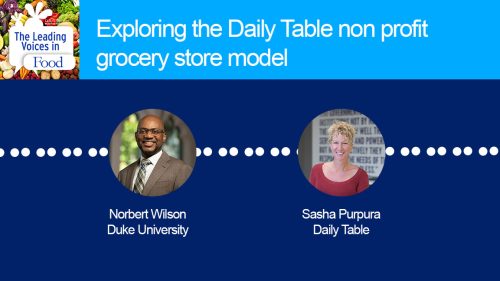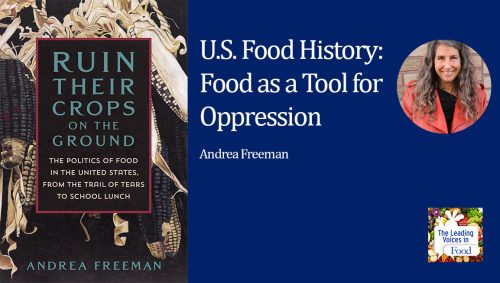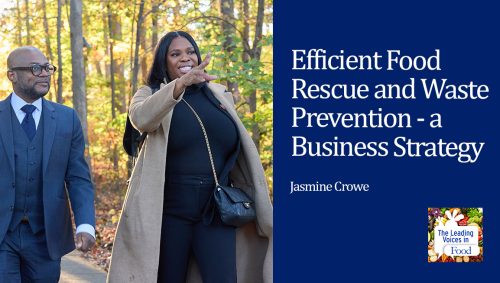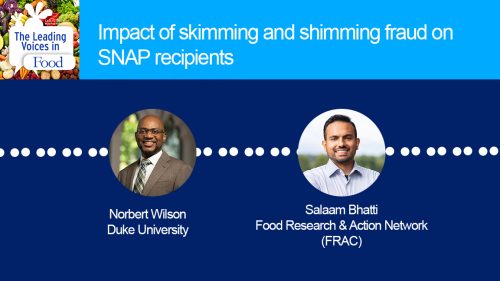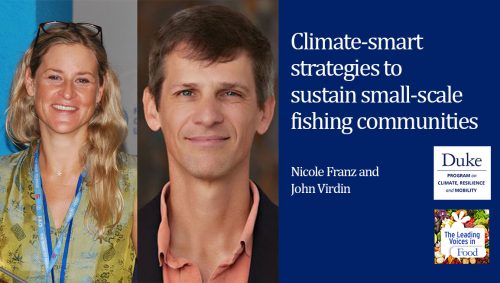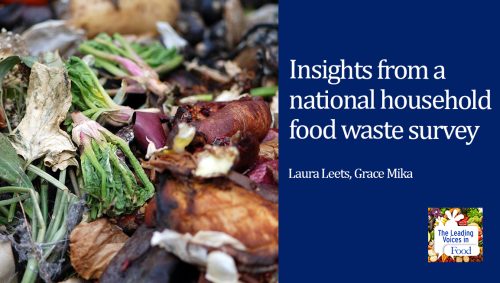The Leading Voices in Food
E260: Food Recovery Network Urges Food Date Labeling Reform
I don’t know about you and your household, but in my home, we have a long history of opening the refrigerator and discovering pasta sauce or mayonnaise that we don’t remember when it was put in the refrigerator, when we last opened it, and we’re confused. We open the container; we smell it; we check out the date label. And if we’re confused, we have a mantra: when in doubt, throw it out. But aren’t those date labels supposed to help us make good decisions about whether or not a food product is safe? Currently, there is no federal regulation on what those labels should say. Best Buy, Use Buy, Sell Buy, or what have you. However, there is legislation in the Congress called the Food Date Labeling Act to help us address this issue. And today’s guest, Regina Harmon, will help us explore this particular issue. She is the executive director of the Food Recovery Network, the largest student led movement fighting food waste and hunger in the United States.

Regina Harmon has been the Executive Director of Food Recovery Network since 2015 and has been a pivotal voice in raising awareness and harnessing action to reduce food waste, end hunger, and positively impact the environment. She has been invited to share her insights with media outlets such as CNN and Al Jazeera and was recognized as one of the most influential leaders in the food industry by SELF magazine and Food Tank. Apart from her position at Food Recovery Network, Regina is also a board member of Food Tank and Earth Island Institute, serves on ReFED’s Advisory Council, and is a member of the Philadelphia artists’ collaborative Pink Noise Projects. Regina emphasizes the need to address the racial disparities in the food system that disproportionately affect the health and economic outcomes of Black, Latinx/Latine, and Native American communities, highlighting the importance of working together to bring about change. Regina holds an MA in Literary and Cultural Studies from Carnegie Mellon University and a BA in English Literature from the University of Maine at Augusta.
Interview Summary
This podcast is co sponsored by the Recipes Food Waste Research Network project led by American University and funded by the National Science Foundation.
First, some of our listeners may not be familiar with the Food Recovery Network. Could you tell us more about the organization and what it hopes to accomplish?
Absolutely. Thank you so much. Food Recovery Network was started in 2011 by college students at the University of Maryland who saw a couple of things happening. They saw a lot of food waste on their college campus, and they also saw a lot of people who were experiencing hunger in their communities. And so, they thought, hey, instead of throwing this perfectly good food away, what we could do is package this food up and give it to those in our neighborhood that we know need some help. And that’s how Food Recovery Network was started. They started at the University of Maryland, one dining hall, one carload of food. They started calling other friends that went to different colleges and universities across the United States. And over the last decade and some change, we’ve grown into, as you said, the largest movement of students who are fighting food waste and hunger. We have about 200 college campuses that have food recovery network chapters. We’ve recovered over 16 million pounds of food through the power of young people. And today we also help other sectors that would like to also do the right thing with their surplus food. We help farms, we help corporate events, large scale events, we help conferences. You name it, wherever there’s surplus food, Food Recovery Network can help make sure that food doesn’t go into landfill and helps feed those in need.
I would love to hear a little bit about who you are able to serve through the Recovered Food. Are you working with food banks? Are you working with the pantries directly? Tell me a little more about that connection.
It’s a beautiful connection. We have about 400 nonprofits all over the United States. That directly receive the surplus food that we donate. We go to the sites where the food is. So again, in college dining halls, large scale events, you name it, and that food is packaged up safely. And then it’s brought to what we call hunger fighting nonprofits. These are nonprofits on the front lines in all of our communities that are in some way feeding our neighbors in need. These are homeless shelters, soup kitchens, food banks. These are domestic violence shelters. These are afterschool programs, churches, anywhere that can also handle the food safely and then distribute it to our neighbors directly. So through that, we’ve been able to meet so many incredible people, and a lot of times volunteers themselves who work at these incredible locations that again, are just helping those who need support to make their ends meet.
Great. This is really important work. Thank you so much for the work that you all are doing. So, how does the Food Recovery Network activate to end food waste and make a positive impact on the environment?
There’s a lot of things that are happening here. You know, millions of tons of food is wasted every single year. And I know we’ll get into the Food Date Limiting Act in just a moment, but every part of our food system, there’s food waste. On farm fields, during transportation, at supermarkets, in our own homes. And so, a lot of times, most of the time, the majority of the time, all of the food that is wasted is actually thrown into landfills. You know, we see those images of whole entire tractor trailer trucks of food being dumped into landfill. And that is the problem. The majority of food, much of which is still perfectly good to eat, perfectly good to consume, is being driven into landfill, where it then is covered up, it begins to rot, and this is where the environmental harm starts. The food rots, and it creates additional CO2 into our environment and other greenhouse gases that is really difficult for our environment to reabsorb because it’s happening at such an increased rate. And that is directly causing what we now know as global warming.
Food all across the United States, all across the globe, is the third largest emitter of CO2 gases. And so that is the environmental issue that Food Recovery Network is addressing. It’s directly harming our atmosphere. But then when we take that step back and we think about all the water it took to grow these plants, all the fuel it took to transport the food, all the fertilizer it took to put into the soil. All of those precious resources are also wasted, and we need to reclaim those resources year after year after year for food that ultimately we are going to throw away, have it cause harm by rotting and going into our atmosphere in the form of CO2 gas. So, it is a really disturbing cycle. Our mission is to recover surplus food to feed everyone who is hungry so that precious food isn’t going into landfill unnecessarily and causing all of that environmental harm.
Yes, this is what I find really critical about the work that you all are doing because of the greenhouse gas emissions from decomposing food and landfills is really problematic, but I’m so grateful for the way you talked about how there are losses, if you will, all along the supply chain from on the farm to the final consumer. I remember even talking to a farmer in Virginia who said, it really breaks his heart to see food wasted. He put a lot of effort, his blood, sweat and tears into that production to see it wasted was just disappointing. And that’s going beyond the environmental costs to just thinking about the value of someone’s labor. I really appreciate what you all are trying to accomplish. But it sounds like you all are involved in the day-to-day work of preventing it from going into the landfill and trying to get into the hands of people. How is it that you all are involved in policy? I’d love to hear how you all are thinking about date labeling and the law that is in the Congress to try to address this challenge.
Thank you so much, Norbert, for that question, because, yes, we are here to feed people through recovering food and donating it and helping our neighbors and being in community with our neighbors. That absolutely must happen. There’s 47 million people who are food insecure all across the United States. We all know somebody who is food insecure. We might not know it. But we do. 47 million people. So that act of not wasting our precious food and bringing it back further into community is vital.
And then at the same time, Food Recovery Network, we are involved in advocacy to begin to correct a system that allows for this food waste and food loss. At the policy level is where we can really begin to recapture all of this precious food that our incredible farmers across the United States are growing for all of us. So, we got involved with the Food Date Labeling Act several years ago, and it has, you know, come up in our Congress a few different times. And we see this as a beautiful way to help reduce confusion around why food is being wasted in the first place. And in particular at the consumer level – our homes. You know, 80 percent of households at some point, they’re going to be confused because of a date label. Again, your story emphasized that so wonderfully because it’s something that we’ve all experienced. About 80 percent of homes are having those same kinds of conversations. The majority of people do believe that date labels are already standardized, and lo and behold, they are not. And so, what we’re trying to do, we’re lending our voice to support the Food Date Labeling Act, so that we can begin to standardize these date labels. And then prevent millions of tons of food from going to waste in the future every single year unnecessarily.
This is the way that I can imagine doing the work that you all are doing, not just on the physical movement of food, but also thinking about the policies that can help support the work that you’re doing. It takes sort of that broad spectrum of approaches to really affect this challenge. But I’ve got to ask, and I hear your passion. I hear your great concern. Can you help us understand why the urgency now? Why, why try to find a permanent solution to food waste today? What’s the impetus?
You’re absolutely right, Norbert. The time is now. We are getting many messages. I will speak from the perspective of our students. So, this is Gen Z, Gen X, Millennials, you know, young people that are on the front lines of this movement to say, we can no longer waste precious food. We were all born [00:10:00] into millions of people being food insecure. That’s wrong. And we know that we can do something about that. We have the simple solution of at least redirecting our precious food to help those in need. So that urgency is now. People are hungry right now. And we have our chapters all across the United States that are doing a food recovery right now. At some point in the day, there’s somebody who is doing the right thing to help say, I can help feed my neighbors in need. There’s nothing more urgent than that.
We know all the hardships that come with being food insecure. And then when we think about our planet. That urgency is now. I tell people all the time if we can all get on board together in this wonderful community to say, we don’t need to waste food any longer. We have the solutions to no longer throw away precious food, and we can begin to, as you said earlier, I love this. To keep that value of the food every single step in the process from seedling to going into our mouths. If we can keep the value of that food, we can really reduce food going into landfill unnecessarily. And then when we can begin to think about that as how we view food, you know, what other problems can we solve together to make our communities thrive for one another?
But in particular with the environment, the time is now. Our food waste is causing environmental harm. We can mitigate that environmental harm by stopping this dizzying, disturbing cycle of wasting food. We’re wasting our potable water. We’re wasting our fertilizer. We’re wasting fuel, gasoline through transportation. And then this food is rotting and it is causing environmental harm, which is going into a larger, broader system of our storms are worse. Our storms are longer. They’re starting earlier. They’re ending later. They’re in places that they weren’t before. This is all part of. the environment that we can help to stem the tide of what we are experiencing as a species. So that’s another reason why the immediacy is now. Let’s not make this worse for the young folks in our lives. Let’s not make this worse for the people who have yet to be born. We can do something now.




